UTS 3 Minute Thesis Finals for 2024
3 Minute Thesis 2024
The Three Minute Thesis (3MT) celebrates the exciting research conducted by Doctor of Philosophy (PhD) and Professional Doctorate (Research) candidates. It is an international academic competition developed by the University of Queensland to cultivate students’ academic, presentation, and research communication skills.
2024 UTS 3MT Finals

From Left to Right: Hannah Jackson (Runner-up, Health), Krisel De Dios (FEIT), Thanh Hoang (Business), Anja Bless (ISF), Rebecca Lewis (Law), Wajiha Pervez (DAB), Minduli Withana (Winner, People's Choice, Science), Yan Chen (Business), Yuya Yanai (FASS)
This year's 3MT finals included an in-person event plus an online session via Zoom. Topics ranged from maternal healthcare, sign linguistics, accounting and auditing practices, regenerative agriculture, athleisure clothing design, First Nations framework for police discretion, osteoporosis to multiple sclerosis. Our judges had the difficult decision of choosing the winner and runner-up award, while our in-person and online audience were busy voting for their People's Choice.
A very special thank you to Aaron Ngan and Stephanie Weiss from UTS startups for all their support of our finalists that included workshops and one on one sessions. Thank you to Dhurata Stanaj from UTS Events, Ria Hamblett and Helen Chan from UTS Library for the event coordination needed to bring this event to life.
Our 2024 judging panel featured:
- Professor Hélène de Burgh-Woodman, Dean of the Graduate Research School
- Professor Jason De Santolo, Associate Dean (Indigenous Research), Office of the Pro Vice-Chancellor Indigenous Leadership and Engagement
- Isabelle Schaefer, UTS 2023 3MT Runner-up winner, Faculty of Health
The 2024 prizes were awarded to:
- Minduli Withana
School of Life Sciences, Faculty of Science
Presentation: Myelin mayhem: PAC1 and the road to MS recovery
First prize: $3000 and representing UTS at the 2024 Asia-Pacific 3MT competition
AND
People's Choice: $1000 - Hannah Jackson
School of Public Health, Faculty of Health
Presentation: Pregnant women get sick too
Runner-up: $1000
See all the event photos (Flickr)
2024 Faculty Finalists
Overall winner and People's Choice Winner: Minduli Withana, Science


Imagine waking up tomorrow to a world where every road and every street you have ever known has been demolished. You are trapped in your home, emergency services are paralyzed and life as you know it comes to a standstill. This is not a dystopian nightmare. It's a harsh reality within the bodies of people suffering with multiple sclerosis. Just like roads connect different cities together, your nerve cells carry important bits of information between different junctions of your body.
In MS, your immune system looks at your myelin, the vital insulating sheet that surrounds and protects your nerve cells and strips it away without myelin just like pop holes in a road your nerve signals stop moving forward in Australia MS claims one to two lives every day over 2 .8 million people worldwide mostly young people that now have and walking, talking, seeing, even thinking.
So what's the solution? For decades, we've tried to manage MS by suppressing the immune system. Unfortunately, this comes along with a whole host of side effects, making people more vulnerable to infection, causing liver and kidney damage, cancer, and there is no cure. That's where my research steps in. I'm interested in this tiny but powerful protein called the Pac -1 protein. I'm interested in Pac -1's role in protecting myelin during MS. I look at how mice experiencing myelin loss fare in the presence or absence of the Pac -1 protein.
So what have I discovered? When PAC -1 is not there, myelin loss is far worse. However, when treated with maxedillin, a compound that switches on the PAC -1 receptor, balance and coordination improve dramatically. It's as if the nerve pathways are rebuilding. As I examine closer, I can see that in the presence of PAC -1, cells in the brain look far less stressed out. So what now?
I'm trying to figure out how PAC -1 protects these nerve pathways. Even better, how can we work towards the new therapies, helping PAC -1 grab that helmet and get to work repairing that damaged myelin?
With PAC -1 in my toolkit, I aim to repair, restore, and redefine what it means to live with MS.

My name is Minduli Withana, and I am a second-year PhD candidate at the School of Life Sciences. I completed my Bachelor of Advanced Science (Pre-Medicine) at UTS in 2021, where I discovered my passion for neuroscience and an interest in studying the impact of inflammation on diseases of the brain. My current research focuses on the PAC1 receptor, investigating its potential as a therapeutic target for Multiple Sclerosis, a debilitating condition that affects many young adults globally. Through my work, I aim to contribute to the development of new treatments that can improve the lives of those affected by this challenging disease.
Runner-up: Hannah Jackson, Health
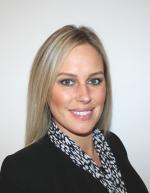
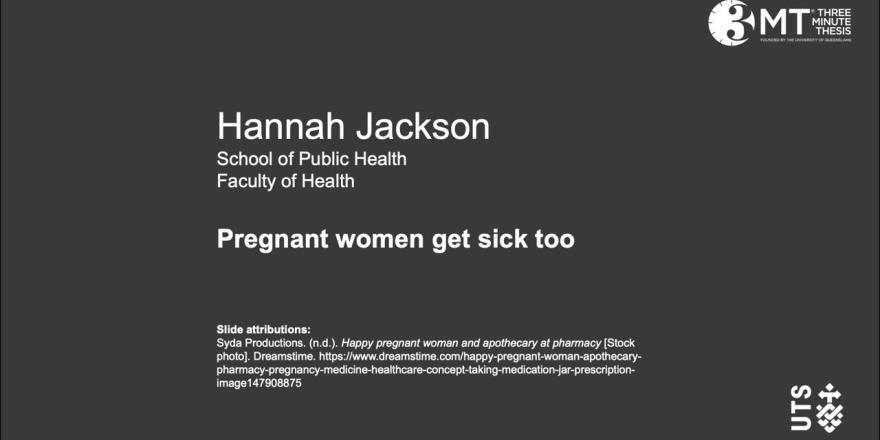
Today, pregnant women across the globe are experiencing significant challenges accessing the medications that they need to keep themselves and their babies safe and healthy during pregnancy.
Now we know that around 70 % of pregnant women experience some sort of medical condition or complication. But for many of these women, medication can feel like a lifeline.
Now picture here is a very common, everyday scenario. A woman in a pharmacy handing over a prescription in exchange for a medication. This all looks pretty familiar and straightforward, doesn't it? But when a woman is pregnant, like this woman is, behind this seemingly simple transaction lies a far more complex reality.
What we can't see in this picture is the genuine concern and anxiety that that pregnant woman has about the unknown effect of that medication for her developing baby. The legal maze that the prescriber had to navigate when writing that prescription, which is fraught with liability concerns, and then there's the financial stress that some women experience paying for certain medications. Now these are not small issues.
They are significant barriers to medication access. So how can we gather the information that we need to overcome these barriers? What are pregnant women currently able to access and how is access to those medications being shaped by drug policy in Australia?
Well, this is where my research comes in. So after diving deep into the language of public health policies and then looking at medication access records for 250,000 pregnant women, some clear themes have begun to emerge from my research findings.
First, public health policies often neglect to acknowledge the specific needs of pregnant women and they are very resistant to change. Second, there is a glaring lack of incentives to develop medications that treat pregnancy -related illnesses. In fact, the current system often dissuades progress in this area. And finally, the Pharmaceutical Benefit Scheme, Australia's main public policy tool for facilitating medication access, now, it's actually doing a pretty good job at distributing approved medications fairly across pregnant women. But overall we're not doing enough to make sure that more pregnancy relevant medications can be approved for use and accessed via this scheme.
Now these emerging findings are being used to drive changes in health policy. We need policies that are more dynamic and we need to harness the powers of existing policy instruments to make sure that every pregnant woman can get access to the medications that they need, because pregnant women get sick too and prioritising their health and wellbeing is crucial for shaping our future generations.

Hannah Jackson is a final year Ph.D. candidate in the Faculty of Health at UTS. Her research focuses on pharmacoeconomics and its intersection with maternal healthcare. With a Bachelor of Pharmacy and a Master of Public Health, she has a strong foundation and a unique perspective to address the complex challenge of balancing efficiency with fairness and justice in healthcare resource distribution. Hannah is passionate about advancing our understanding of the economic factors that drive resource allocation decisions for pregnant women. She aims to improve access to safe, effective, and affordable medications for all pregnant women.
Yuya Yanai, Arts and Social Sciences
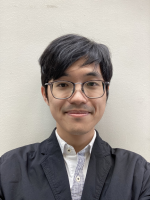

[signing “Hello, my name is Yuya” in Hong Kong Sign Language]
This is Hong Kong sign language, but you seldom see it in Hong Kong. It is not well acknowledged. But what if we do see or even use it in our daily lives?
Is there such a space? This is the beginning of my research. At one high school in Hong Kong, deaf and hearing students learn in the same classroom using sign, written, and oral languages. As a hearing person, my research investigated the communication methods between the deaf and hearing students at that high school and what we can learn from their practice.
Previous research on deaf and hearing students' communication has mostly focused on language and students. But from my experience as a sign language researcher, this focus was not enough to fully explain what was happening in the high school I studied. So my research expanded the focus to include various methods beyond language and shared spaces where students interact daily.
To collect data, I spent eight months on observing classes and also participating in their lunchtime interaction and after-school baseball craft activities at the high school. I then interviewed the students and their teachers. What I discovered was a close relationship between the communication methods and the space of their interaction.
For example, in classrooms, students often used writing and drawing, which became possible because of blackboards. In contrast, at the playground, students frequently used gestures with objects. Furthermore, some high school students often spoke and signed at the same time. A key finding was that over time these interactions became the norm among the students.
My research demonstrates that creating a shared space is the first step to initiating communication, just like, (while pointing to the venue), right now. My question to you is, for the next step, how can deaf and hearing people directly communicate in an effective and respectful manner? My research invites you to consider how our communication is shaped by us, and the space.

こんにちは、你好!
Hello! My name is Yuya Yanai. I am a fourth-year Ph.D. candidate at the Faculty of Arts and Social Sciences. My encounter with sign linguistics and Deaf studies during my Master's course inspired my Ph.D. research. I am investigating everyday interactions between Deaf and hearing people in the Sign Bilingualism and Co-enrolment Education Programme (SLCO) in Hong Kong.
In addition to my research, I am a Japanese tutor at UTS and a dedicated learner of Auslan, Hong Kong Sign Language, and International Sign.
ORCID | LinkedIn
Wajiha Pervez, Design, Architecture and Building
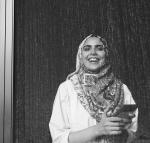
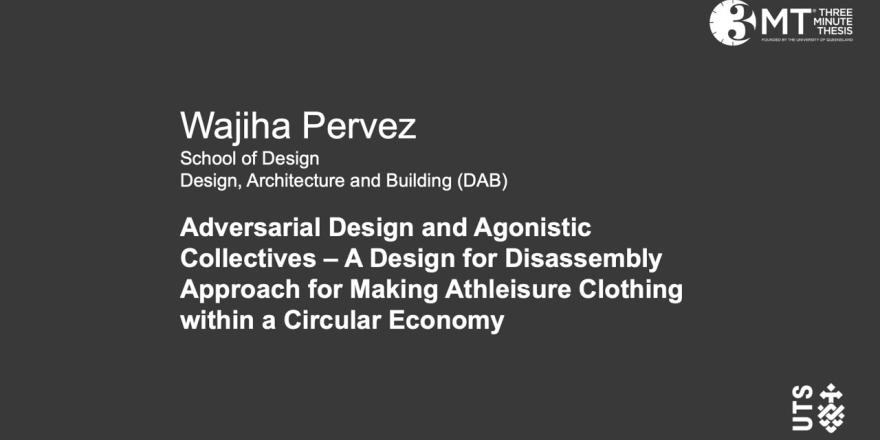
Australia is the world's fastest growing consumer of athleisure clothing and average athleisure clothing looks something like this, a combination of top pants and perhaps a jacket that is fit for light exercise and everyday casual wear. There are four sustainability concerns with this fit though.
Number one, 95 % of it is non -compostable petrochemical fibers. Number two, it gives me excellent compression to tuck away my curves, but I sweat through it, and every time I do that, I absorb harmful chemicals and microplastics. Number three, at the end of its life, it sits in the environment for a hundred years where it further degrades into microplastics that endanger land and marine ecosystems. Number four, every year Australia produces 17.2 metric tons of post-consumer and athleisure waste, which is equal to 172 times the weight of the Eiffel Tower.
But this is not just the only waste. Another 17% waste happens offshore in the garment supply chains that no designer has control over. In fact, contrary to the popular belief that the designers make decisions about the entire product lifecycle, an athleisure designer working in the industry is only responsible to ensure 8 % accuracy to meet UN sustainable development goal number 12, sustainable consumption and production. Which includes decisions such as what materials and finishes to use, where to produce the garments and how to build an end of life disassembly plan within the garment materiality.
My thesis claims back this 8 % power and expands it to 100%. What if I tell you that your athleisure clothing can look playful and absolute bangers like these? They will be playful, sustainable, wick away moisture, will not pill and can be decomposed into biodegradable fibers at the end of their life.
So how am I doing this? Enter generative AI and seamless knitting. I'm using generative AI to model my garments and generative AI to knit these at the UTS knit lab.
The entire process is inherently zero waste. The garments are made with super fine Australian merino wool that doesn't pill, wicks away moisture, biodegrades into the soil and is custom made for your body.
But my research just doesn't stop here. It also empowers athleisure designers to not be threatened by AI, taking over their job, but use it as an important sustainability tool.
Thank you.

Wajiha Pervez is an experimental textile designer and academic.
She researches relationships between designers, generative AI, craft, and materials in the context of sustainable fashion and circular economy.
Her work has been showcased in exhibitions and conferences in Australia, Dubai, Qatar, Italy, Russia, the U.K, & Iran.
Web site | PhD work snippets | Sydney Morning Herald Feature
Krisel De Dios, Engineering & IT


This is healthy aging where it is still very possible to live a happy, active life at this age. But looking around the room, our current sad reality is one in three of us will have osteoporosis when we're 50 years and above. This is followed by fractures at your hip or spine.
To be clear, these fractures are not from high impact trauma like sporting or motor vehicle incidents. These fractures are when your bone has become so weak and brittle that a simple fall from a standing height will shatter your bone, stealing seven years off your life. Stealing time you could be spending with your loved ones. Seeing your kids, grandkids grow up.
Having that quality time with our parents, grandparents, and friends when they're older. If we want to reclaim the years austere process takes from us, we must go to the "Prevent bone loss, you prevent fractures." To do this, we must look into the blueprint of life, our DNA, which is composed of six billion DNA letters and can reveal why some people lose a lot of bone tissue, but others, not so much, even with the same lifestyle habits.
Why? My research aims to uncover this mystery in our DNA by scanning over 20,000 people from Vietnam, the US, Europe, and Australia, identifying the unique patterns in our DNA to predict bone loss from birth. That's right, from birth and to predict those who are low to high risk of excessive bone loss, allowing our medical professionals to prescribe early preventative action through simple lifestyle modifications, like diet, exercise, that are most importantly, personally tailored to your unique genetic profile, leading to the prevention of fractures and elevating the time and quality of life within our community, gifting us that extra precious time to make memories with our loved ones. Thank you.

Krisel De Dios is a second year PhD student in the School of Biomedical Engineering in the Faculty of Engineering and Information Technology. She is a part of Prof Tuan V Nguyen’s Osteoporosis Research group. Krisel is deeply passionate and curious about how human health and diseases are driven by genetics. For her research, she is conducting a genome-wide association study on bone loss to uncover new genetic factors related to bone loss. Subsequently, using these genetic factors to revamp current diagnostic tools for osteoporosis and employ early intervention from birth. She hopes to translate her project’s findings into individualised care and treatment of the community, contributing to the new paradigm shift of personalised medicine.
LinkedIn
Anja Bless, Institute for Sustainable Futures (ISF)


I want you to close your eyes for a moment and imagine yourself standing in a field full of happy cows munching away on lush green grass. The paddock is lined by native trees for wildlife to pass through.
You can hear bugs and bees buzzing almost feel the farm humming with life. This is the kind of farm that's typical of the growing regenerative agriculture or Regen ag movement an approach to farming that aims to rejuvenate the soil water and nutrient cycles of our farms and it sounds pretty great, right? But is it enough to fix our food system? Because our food system is coming at a huge environmental and social cost. We're poisoning our air and waterways, removing natural habitat and ruining our soil.
Even though we're producing more food than ever before, 20 % of it is wasted, while many people in the world are starving. Others suffer from diseases caused by ultra -processed foods, or are eating too much of things like red meat, which is driving up greenhouse gas emissions. Almost every part of our food chain is dominated by just four companies, while everyday people struggle to access land to grow food. My thesis explores where Regenag fits amongst these social and political challenges to see whether it can help to transform our food system for the better.
I interviewed 40 farmers, policymakers, and indigenous agriculturalists from across Australia and looked at how governments, agricultural organizations, and companies in Australia and globally are getting involved in the movement.
What I found is that while Regen Ag may have some great benefits on farm, it's not really doing much to fix things beyond the farm gate. Regen is really expensive to switch to.
And so Regen farmers tend to be rich or have inherited their farm and there's little support for people without access to land or for poorer farmers to make the switch. Regen farmers also are typically selling red meat into global commodity chains, which is driving climate change, or to rich consumers who can afford their premium product. What's more, companies like Nestle, Unilever, McDonald's, Bayer and PepsiCo are all establishing Regen Ag programs and seem to be slowly taking over the movement. They're using the Regen Ag label for greenwashing, making themselves seem more environmentally friendly while justifying their position of power and I didn't find any active or collective efforts among Regen farmers to resist this infiltration of their movement.
So what's next? Well there needs to be more support for people without access to land or who are struggling to switch to Regen ag to get involved. Regen farmers can also connect with other groups and movements who are fighting system issues like corporate power to make a like -minded group of coalition of people to make a positive change, because while Regenegue may be one part of the solution, if we're going to fix the food system we have to look at the whole picture.

Anja Bless is a PhD candidate with the Institute for Sustainable Futures at the University of Technology Sydney where she is researching the politics of regenerative agriculture.
Her focus areas are environmental politics, food politics and policy, sustainable food systems, and sustainable consumption.
Rebecca (Beck) Lewis, Law
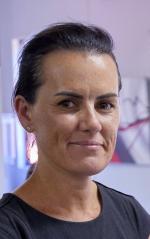
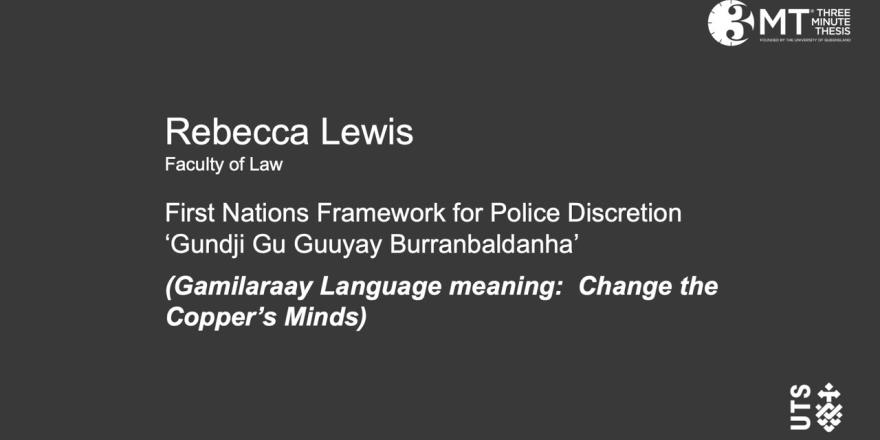
You need to go change the Gunjies mindset to help our people. That was the clear message given to me prior to joining the NSW police force by my elders.
Gunjies to my elders means police and is the title of my thesis. Hi, my name's Bec Lewis. I am a proud Gomeroi Murri Yinnar woman from Moree NSW.
I recently resigned from the New South Wales police force where I was a police officer for 21 years, I know, hard to believe. Discretion has always been a passion of mine, in particular the way it's used in First Nation communities, and this passion still continues throughout my research. Police discretion are the decisions that police make every day in every given situation. Those decisions are based on legal options within the provisions of the law itself.
However, very clear in literature is the way discretion is used in First Nations communities. It is one that is unjust, it is unfair, it is not equal, it is harsh, and it leads to the overrepresentation of First Nations people coming into contact and entering the criminal justice system. But also, there is a clear gap in the research too and that gap is looking at police discretion from a First Nations person's lens, from a culturally strength based lens to inform a First Nations police discretion framework, to embed in police education in order to reduce the overrepresentation of First Nations people coming into contact with the criminal justice system.
This research is qualitative study. It comes from an Indigenous standpoint theory, in particular, Winangali, Gomeroi practices, which is inner deep listening. And also, there's a picture of that on the slide as well. The reason I'm doing this research is it's invaluable. It brings the cultural expertise of First Nations Aboriginal police officers.
It brings the cultural expertise of my Aboriginal elders back home on Gomeroi country. This is invaluable because it's their cultural knowledge, it's their cultural wisdom,
It's their strength and resilience of the oldest living and surviving culture in the world. And that has value. And to my Gomeroi elders back home in Moree, this research is for you.
And yes, let's do this. Let's change the Gunjies mindset in order to help our our people. And let's make a difference. Thank you.
Rebecca (prefers Beck) Lewis is a proud Gomeroi Woman from Moree NSW. She also has connections to Dunghutti (Walcha NSW) and Ngoorabul (Glen Innes NSW). Rebecca has 21 years of experience working with the NSW Police Force in various roles, including front line general duties policing, Senior Forensic Investigator (Accredited Fingerprint Expert), Project Manager at the Aboriginal Employment Programs Unit/Aboriginal Coordination Team and First Nations Coordinator at NSW Police Academy in Goulburn NSW.
Rebecca recently resigned from her position as a Sergeant to pursue her passion for research and education, particular in social justice for First Nations communities.
Thanh Hoang, UTS Business School


Did you know that if you Google the five biggest firm in the world, think Apple, Amazon, Microsoft, you will find that their combined market capitalization is an astounding $11 trillion.
But if you look at their financial statement, their combined total asset is only around $1 trillion. So where is the missing $10 trillion of dollars?
Intangible assets. These assets with our physical form such as knowledge, innovation, brand awareness, customer data that these firms generate.
And the reason for this shocking gap is because the accounting standard do not allow the recognition of intangible assets that firms generate by themselves.
Intangibles are only recognized if they are purchased from another firm. Imagine, if you and I are investors of this large public firm, how can we know about these intangibles? We will have to rely on the disclosures that firm make about their own intangibles. Now, unfortunately, the problems with these disclosures are one, they are not compulsory, and two, they are not checked by an independent auditor. And because CEOs have incentive to promote themselves for better personal reputation, higher bonuses, we cannot always trust the credibility of their disclosures. Ten trillion from just five firms, that's six times the size of the Australian economy.
What if these missing trillions is actually missing? What if these disclosures are just talked without any real substance? In my research, I provide a way to verify these disclosures. And this can be done when firms with intangible assets are to an order firm, because remember, intangible assets are only recognized and audited when they are purchased. By using this purchase audited value as a benchmark, I can examine the credibility of disclosure on this intangible asset by comparing it to the audited fair value of the same set of assets.
The findings of my research will help close the trillion-dollar information gap around unrecognized intangible assets, helping regulators and investors like you to make better, more informed decisions. Thank you.

Thanh is a PhD candidate at the UTS Business School, Accounting Discipline Group. Her PhD focuses on the credibility of firms' voluntary disclosure on intangible assets. Thanh holds a Master of Professional Accounting degree with High Distinction, a full-fee scholarship, the Dean’s Merit Award, and First-Class Honours. Her Bachelor of Business degree was funded by two academic excellence scholarships and enriched by an exchange in Switzerland. In her free time, she enjoys painting, dancing, and playing music.
Yan Chen, UTS Business School
2024 UTS 3MT Wildcard Competition Winner


One million – one million is the number of fake bank accounts employees at Wells Fargo had opened to meet sales targets. In 2016, the Wells Fargo fraud scandal shocked the financial world. A critical question was raised: where was the auditor?
Auditors are the detectives of the business world. Much like Sherlock Holmes investigating a case, they review financial records to uncover discrepancies. Their work is essential, everyone is an investor in some way – through financial investments, our retirement funds, or the companies we work for. Auditors provide crucial assurance over financial statements, enabling us to make informed decisions.
Current standards require auditors to consider clients’ regulatory environment in the auditing process. However, KPMG, the auditor of Wells Fargo, was aware of the fraud but did not alert the public. This situation highlights the need for auditors to address regulatory compliance more thoroughly. And in response, standard setters propose to expand the scope of audits to include a more detailed examination of regulatory compliance and to clarify auditors' responsibilities.
Despite its importance, we know little about the impact of regulatory compliance on auditing. My study explores this by asking: what do auditors think about their clients’ regulation levels?
I analysed data on the fees auditors charge and companies’ regulation exposure levels. The results reveal that companies subject to higher regulatory oversight pay about 2% less in audit fees. This is because these firms are less risky – they have stronger fraud prevention, better quality of reporting, and fewer lawsuits.
These findings are encouraging. While regulations are often seen as a “burden”, my findings show that, regulatory compliance effectively guides business activities and promotes accountability. This mirrors our own experiences: while work reports and progress reviews can feel tedious, they help us improve and stay accountable.
So, what does this all mean? It means that auditors are effectively navigating complex regulations. The potential increase in audit fees due to proposed standard changes is likely not a concern, but a worthwhile investment in enhancing reliability of financial information and keeping us investors safe. Thank you.

Yan is a PhD candidate from the Accounting Discipline Group at the UTS Business School. Yan holds a Bachelor of Business (Honours) with First Class Honours and University Medal from UTS. Her research focuses on understanding the economic consequences of regulation in an accounting context. Yan is also passionate about teaching and fostering a learning environment that encourages curiosity, independent learning, and critical thinking.
